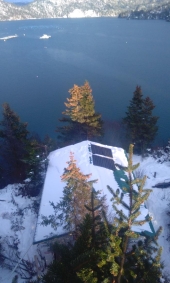




This too is meaningless. A chasing after the wind.
 2
2




Silence is Golden
For all your RMH needs:
dragontechrmh.com
 3
3






 1
1









This too is meaningless. A chasing after the wind.





God of procrastination https://www.youtube.com/watch?v=q1EoT9sedqY




Satamax Antone wrote:Careful, downdraft tubes don't work very well in rockets. Most of the time.
This too is meaningless. A chasing after the wind.




William LeMieux wrote:So, all downdrafts are not created equal? Please explain the differences between the downdraft in a bell design and the downdraft in a tube design. They both have them.
In my minds eye the main function of the heat riser is to thoroughly burn the gasses locked inside the wood. By the time the gasses reach the top of the riser, that function has already taken place. The bell or downdraft tube is simply a means by which the gasses would exit the heat riser, cool, then sink. By having the downdraft tube isolated from the heat riser, the downdraft tube would naturally be cooler since it's not absorbing any heat from the riser. It should function better than a bell design.
That's the way I see it anyway. Please correct me if I'm wrong and point out any flaws in my thinking.
regards, Peter
 2
2




regards, Peter





God of procrastination https://www.youtube.com/watch?v=q1EoT9sedqY




Peter van den Berg wrote:
...Moreover, hot gases tend to stay in the highest region so the heat stress will be enormous in that spot.
In other words: where heat stress in a barrel or bell is spread out, this isn't the case in a U-turn. So heat stress will be concentrated in the bend of the U-turn.
But if you want to see for yourself, please build it and post the results.
This too is meaningless. A chasing after the wind.




Satamax Antone wrote:Hot gases tend to rise so in the downdraft leg you would be pushing hot gases down. Not sure the riser can push this. It already strugles with a barrel without chimney.
This too is meaningless. A chasing after the wind.




This too is meaningless. A chasing after the wind.















NopeWilliam LeMieux wrote:
Satamax Antone wrote:Hot gases tend to rise so in the downdraft leg you would be pushing hot gases down. Not sure the riser can push this. It already strugles with a barrel without chimney.
But isn't the same thing happening with a bell system?
God of procrastination https://www.youtube.com/watch?v=q1EoT9sedqY




 Does any of that matter in the grand scheme of things? And if it's surface area in the downdraft tube I'm after, perhaps the I.D. could be made larger? Is there a ratio of air volume between the riser and downdraft tube one should adhere to?
Does any of that matter in the grand scheme of things? And if it's surface area in the downdraft tube I'm after, perhaps the I.D. could be made larger? Is there a ratio of air volume between the riser and downdraft tube one should adhere to? This too is meaningless. A chasing after the wind.





God of procrastination https://www.youtube.com/watch?v=q1EoT9sedqY
 1
1




Satamax Antone wrote:Well, i don't want to wreck your dreams. But to act vaguely as a bell, your downdraft tube should be 5 times the CSA of the heat riser. And that's an absolute minimum.
So, please, build it, and report.
Have you ever built a working Rocket before?
This too is meaningless. A chasing after the wind.




This too is meaningless. A chasing after the wind.

 1
1








This too is meaningless. A chasing after the wind.

 1
1




God of procrastination https://www.youtube.com/watch?v=q1EoT9sedqY

 1
1




 1
1




This too is meaningless. A chasing after the wind.

 1
1




William LeMieux wrote:Satamax- I'm not sure what the animation is suppose to represent sir. Nor do I know what CSA or ISA means. If you would be so kind...
God of procrastination https://www.youtube.com/watch?v=q1EoT9sedqY





This too is meaningless. A chasing after the wind.





God of procrastination https://www.youtube.com/watch?v=q1EoT9sedqY

 1
1








This too is meaningless. A chasing after the wind.




This too is meaningless. A chasing after the wind.

 2
2









 2
2













This too is meaningless. A chasing after the wind.





William LeMieux wrote:Thank you gentlemen for your insight into my query. It gave me a lot to ponder. And Graham- that was an interesting article, I thank you for that.
Now about the Ceramic blanket (which is also available in board form) on the inside of the heat riser, etc. I immediately saw how that would be useful. Being exposed to direct flame, does the blanket, or board, ever need replacing? Does it wear out over time?
Also, if the insulation was on the inside of the firebrick, I would think the firebrick would expand and contract less and therefore less likely to crack at the mortar joints? Is this a correct assumption? I'm asking because of the video above where the guy said his brick bell eventually cracked and leaked real bad. If the ceramic blanket were below the top layer of brick (at the top of the heat riser), perhaps the cracking, and therefore leaking, might have been prevented?
God of procrastination https://www.youtube.com/watch?v=q1EoT9sedqY






|
rubbery bacon. rubbery tiny ad:
The new gardening playing cards kickstarter is now live!
https://www.kickstarter.com/projects/paulwheaton/garden-cards
|

-Modifications-to-Steel-cored-RMH.jpg)
-Completed-steel-RMH-(Notice-space-for-airflow-under-and-up-the-back-side-of-the-external-mass.).jpg)





